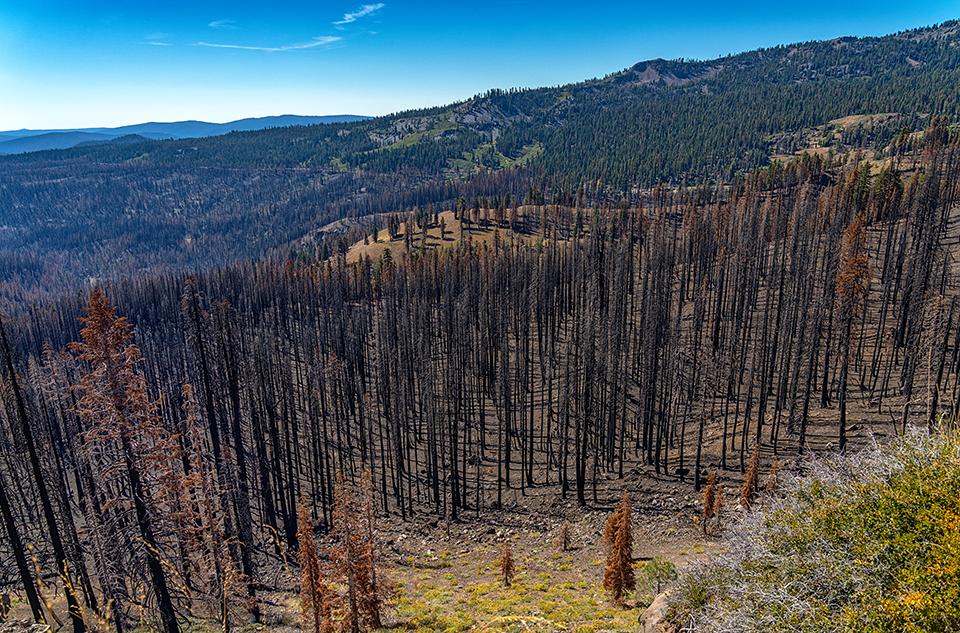
The National Park Service and U.S. Forest Service are working on complementary programs to reduce wildland fires/Rebecca Latson file
Efforts are continuing within the Interior Department and the National Park Service to develop strategies to reduce the threats of wildfire on public lands, an endeavor complementary to work being conducted by the Agriculture Department.
Last week the Agriculture Department announced expanded efforts to reduce wildfire risk across the Western United States with funding through the Bipartisan Infrastructure Law and the Inflation Reduction Act.
Since releasing its Wildfire Crisis Strategy one year ago, the U.S. Forest Service and its partners have worked to identify the highest risk landscapes for treatment projects, according to an agency release. The Forest Service found that around 80 percent of the wildfire risk to communities is concentrated in less than 10 percent of firesheds. These targeted investments focus on firesheds of the highest risk, where projects are ready to begin or to expand.
USDA's 10-year strategy calls for treating up to 20 million acres on national forests and grasslands and up to 30 million acres on other federal, state, tribal, private and family lands to assure the forests are more resilient to wildfire and other effects of climate change, safer for communities, and remain key refuges for plants, fish and wildlife.
As a bureau within the Department of the Interior, the Park Service is part of DOI’s Five-Year Plan, which complements USDA’s 10-Year Strategy in emphasizing fire-prone DOI and tribal lands comprising up to 30 million additional acres. These include rangelands and other vegetative ecosystems that pose serious fire risks.
"DOI will continue to work with USDA to build partnerships, use existing resources, and invest in technologies and tools that are needed to better inform risk and empower stakeholders to make collaborative decisions that protect people, communities, and resources from the risks of wildfire," Tina Boehle, branch chief, communication and education, within the Park Service's Division of Fire and Aviation Management told the Traveler in an email last week.
"This will facilitate a collaborative, multijurisdictional approach to reducing wildfire risk over broad landscapes," she said. "Additionally, DOI will look for opportunities to improve efficiencies, use existing statutory and administrative authorities, and leverage processes to increase the pace and scale of priority fuel management treatments."
The complementary programs are expected to inform development of a joint USDA and DOI long-term, outcome-based monitoring, maintenance, and treatment strategy that is required by Section 40803(j)(2) of the Bipartisan Infrastructure Law by 2026 focused on:
- Maintaining forest health improvements and wildfire risk reduction accomplishments.
- Continuing treatments at levels necessary to address the 20 million acres that need priority treatment.
- Proactively conducting treatments at a level necessary to minimize the risk of wildfire to surrounding at-risk communities.
In addition, the NPS Wildland Fire Program is working on goals towards its Wildland Fire Strategic Plan, which is in force through next year. That plan supports five of the Interior Department's priorities: conservation stewardship legacy second only to President Theodore Roosevelt; restore trust and be a good neighbor; protect people and the border; strike a regulatory balance; achieve agency goals and lead Interior's team forward. Specifically, this strategic plan addresses the Secretary of the Interior’s direction for active management of forests and fuels:
- use existing policies more aggressively;
- think differently about how those policies may be applied;
- look for opportunities to partner with adjacent agencies, state and local governments, tribes, and private landowners to maximize resources;
- look carefully at existing management plans and ask if you are doing all you can today to address the threats of tomorrow;
- ensure that our landscapes are restored and maintained to meet the department's mission.
A selection of past Traveler stories about wildfire in the National Park System:
This Fall's Wildfires Claimed 3-5% Of The World's Giant Sequoias
Traveler Special Report: Coping With 21st Century Wildfires
National Parks Traveler Episode 133: Wildfires In the Parks
NPS Proposes Seeding Of Giant Sequoia To Replace Those Burned
How Fire Left Its Mark on the Smoky Mountain Landscape
Summer Of '22 Expected To Be Smoky In Western National Parks


